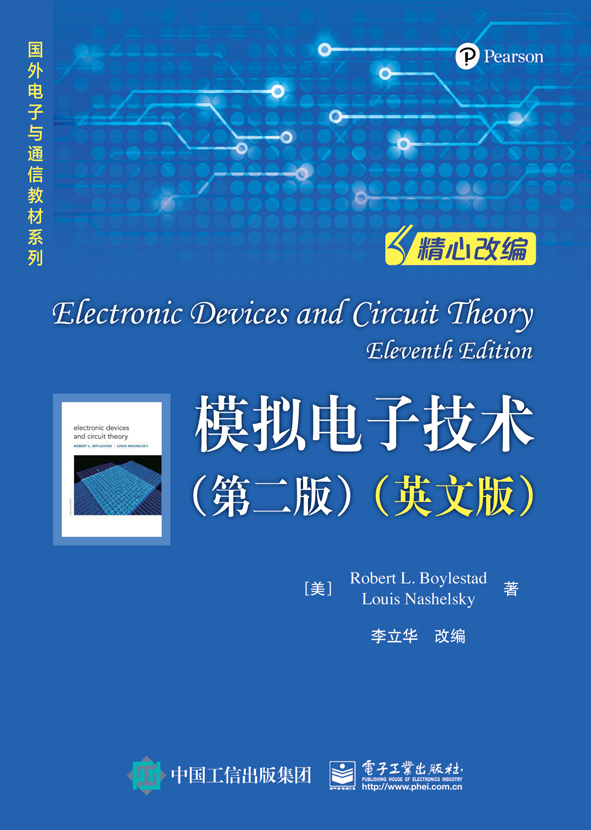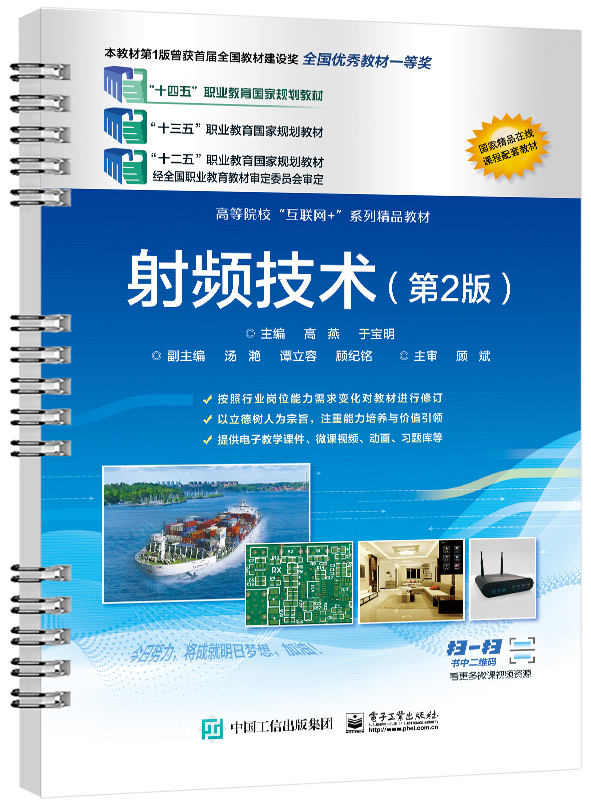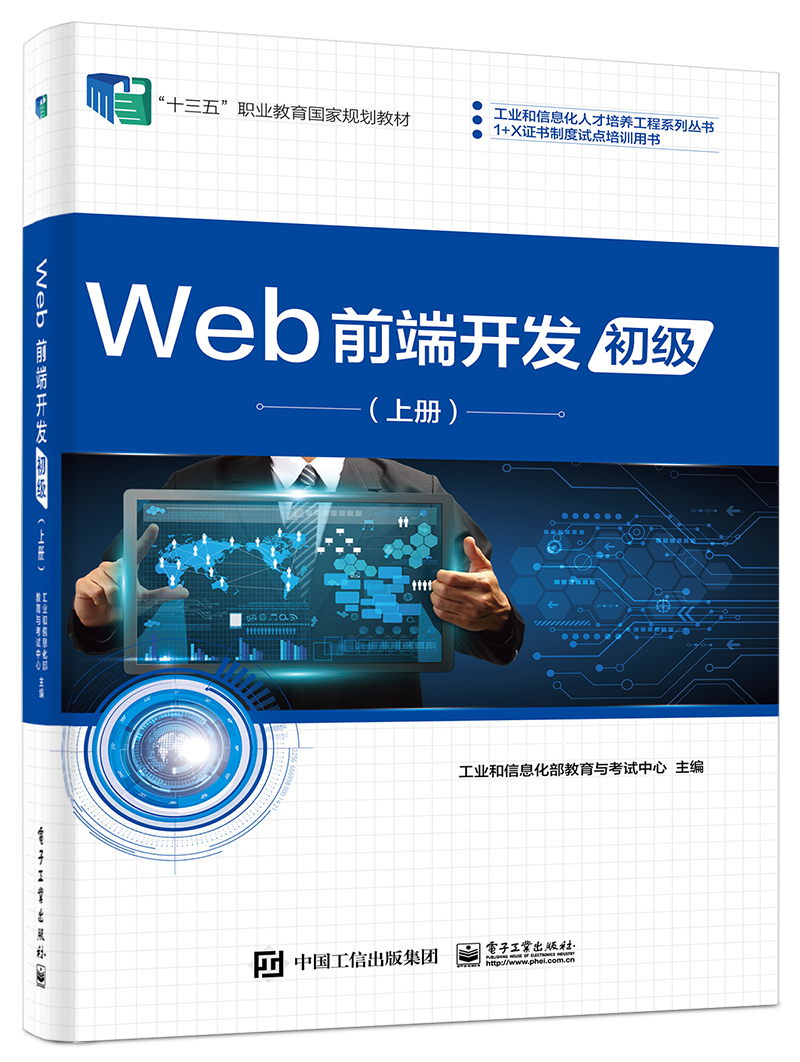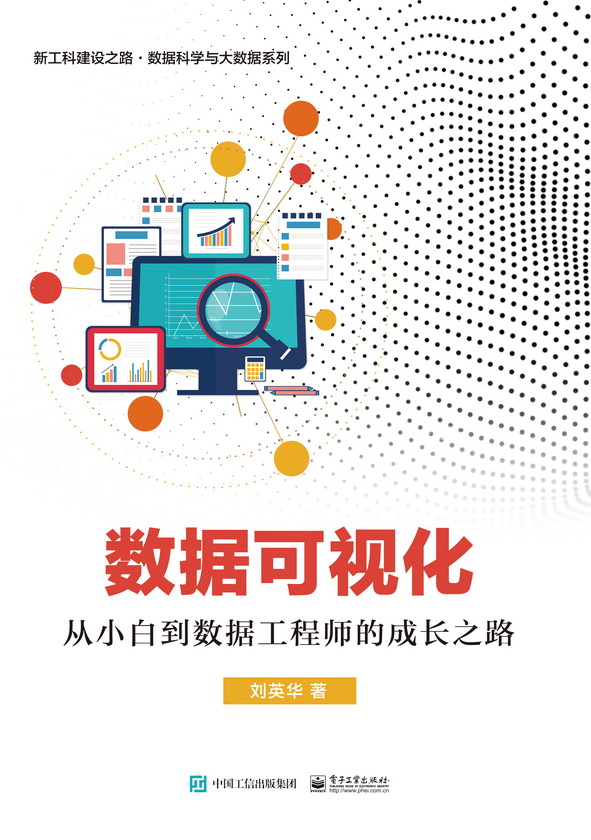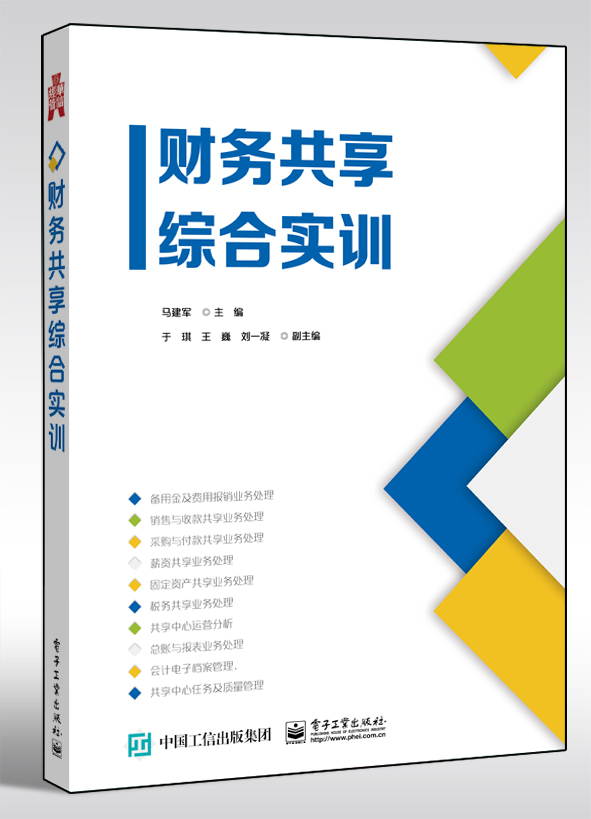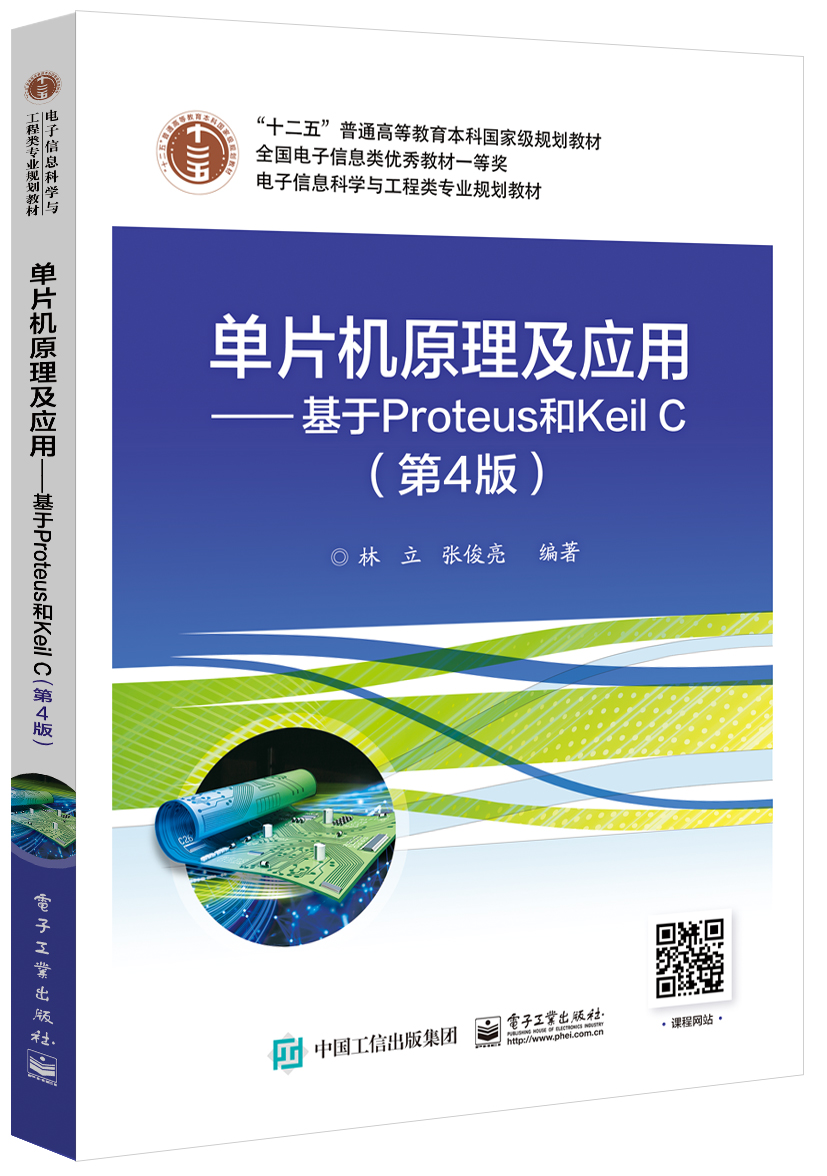模拟电子技术(第二版)(英文版)
丛 书 名:
国外电子与通信教材系列
作 译 者:李立华
出 版 日 期:2016-07-01
书 代 号:G0289150
I S B N:9787121289156
图书简介:
本书向授课教师提供英文原版教辅(习题解答,PPT,改编者提供的PPT),具体申请方式请咨询Te_service@phei.com.cn。本书包括半导体器件基础、二极管及其应用电路、晶体管和场效应管放大电路的基本原理及频率响应、功率放大电路、多级放大电路、差分放大电路、电流源等模拟集成电路的单元电路、反馈电路、模拟集成运算放大器、电压比较器和波形变换电路等。本书对原版教材进行了改编,精简了内容,突出了重点,补充了必要知识点,内容更加新颖和系统化,反映了器件和应用的发展趋势,强调了系统工程的概念。
定价 89.0
您的专属联系人更多
联系人:李蕊
电话:010-88254558
邮箱:lir@phei.com.cn
-
配 套 资 源图书特别说明:由于成本考虑,本书不作为参考书赠送。如果确有授课教材选用的需求,可将详细情况发送给本书专属联系人,我们将进一步沟通并酌情处理。
本书资源
会员上传本书资源
-
图 书 内 容
内容简介
本书向授课教师提供英文原版教辅(习题解答,PPT,改编者提供的PPT),具体申请方式请咨询Te_service@phei.com.cn。本书包括半导体器件基础、二极管及其应用电路、晶体管和场效应管放大电路的基本原理及频率响应、功率放大电路、多级放大电路、差分放大电路、电流源等模拟集成电路的单元电路、反馈电路、模拟集成运算放大器、电压比较器和波形变换电路等。本书对原版教材进行了改编,精简了内容,突出了重点,补充了必要知识点,内容更加新颖和系统化,反映了器件和应用的发展趋势,强调了系统工程的概念。图书详情
ISBN:9787121289156开 本:16开页 数:608字 数:1265.0本书目录
Chapter 1 Semiconductor Diodes 1.1 Introduction 1.2 Semiconductor Materials: Ge, Si, and GaAs 1.3 Covalent Bonding and Intrinsic Materials 1.4 Extrinsic Materials: n-Type and p-Type Materials 1.5 Semiconductor Diode 1.6 Ideal Versus Practical 1.7 Resistance Levels 1.8 Diode Equivalent Circuits 1.9 Transition and Diffusion Capacitance 1.10 Reverse Recovery Time 1.11 Diode Specification Sheets 1.12 Semiconductor Diode Notation 1.13 Zener Diodes 1.14 Light-Emitting Diodes 1.15 Summary 1.16 Computer Analysis Problems Chapter 2 Diode Applications 2.1 Introduction 2.2 Load-Line Analysis 2.3 Equivalent Model Analysis 2.4 AND/OR Gates 2.5 Sinusoidal Inputs; Half-Wave Rectification 2.6 Full-Wave Rectification 2.7 Clippers 2.8 Clampers 2.9 Zener Diodes 2.10 Summary Problems Chapter 3 Bipolar Junction Transistors 3.1 Introduction 3.2 Transistor Construction 3.3 Transistor Operation 3.4 Common-Base Configuration 3.5 Transistor Amplifying Action 3.6 Common-Emitter Configuration 3.7 Common-Collector Configuration 3.8 Limits of Operation 3.9 Transistor Specification Sheet 3.10 Transistor Casing and Terminal Identification 3.11 Summary Problems Chapter 4 DC Biasing — BJTs 4.1 Introduction 4.2 Operating Point 4.3 Fixed-Bias Circuit 4.4 Emitter Bias 4.5 Voltage-Divider Bias 4.6 DC Bias with Voltage Feedback 4.7 Miscellaneous Bias Configurations 4.8 Transistor Switching Networks 4.9 pnp Transistors 4.10 Bias Stabilization 4.11 Summary Problems Chapter 5 BJT AC Analysis 5.1 Introduction 5.2 Amplification in the AC Domain 5.3 BJT Transistor Modeling 5.4 The re Transistor Model 5.5 The Hybrid Equivalent Model 5.6 Hybrid Model 5.7 Variations of Transistor Parameters 5.8 Common-Emitter Fixed-Bias Configuration 5.9 Voltage-Divider Bias 5.10 CE Emitter-Bias Configuration 5.11 Emitter-Follower Configuration 5.12 Common-Base Configuration 5.13 Collector Feedback Configuration 5.14 Collector DC Feedback Configuration 5.15 Determining the Current Gain 5.16 Effect of RL and Rs 5.17 Two-Port Systems Approach 5.18 Summary Table 5.19 Cascaded Systems 5.20 Darlington Connection 5.21 Feedback Pair 5.22 Current Mirror Circuits 5.23 Current Source Circuits 5.24 Approximate Hybrid Equivalent Circuit 5.25 Summary Problems Chapter 6 Field-Effect Transistors 6.1 Introduction 6.2 Construction and Characteristics of JFETs 6.3 Transfer Characteristics 6.4 Specification Sheets (JFETs) 6.5 Important Relationships 6.6 Depletion-Type MOSFET 6.7 Enhancement-Type MOSFET 6.8 CMOS 6.9 Summary Table 6.10 Summary Problems Chapter 7 FET Biasing 7.1 Introduction 7.2 Fixed-Bias Configuration 7.3 Self-Bias Configuration 7.4 Voltage-Divider Biasing 7.5 Depletion-Type MOSFETs 7.6 Enhancement-Type MOSFETs 7.7 Summary Table 7.8 Combination Networks 7.9 p-Channel Fets 7.10 Summary Problems Chapter 8 FET Amplifiers 8.1 Introduction 8.2 FET Small-Signal Model 8.3 JFET Fixed-Bias Configuration 8.4 JFET Self-Bias Configuration 8.5 JFET Voltage-Divider Configuration 8.6 JFET Source-Follower(Common-Drain) Configuration 8.7 JFET Common-Gate Configuration 8.8 Depletion-Type MOSFETs 8.9 Enhancement-Type MOSFETs 8.10 E-MOSFET Drain-Feedback Configuration 8.11 E-MOSFET Voltage-Divider Configuration 8.12 Summary Table 8.13 Effect of RL and Rsig 8.14 Cascade Configuration 8.15 Summary Problems Chapter 9 BJT and FET Frequency Response 9.1 Introduction 9.2 General Frequency Considerations 9.3 Low-Frequency Analysis Bode Plot 9.4 Low-Frequency Response BJT Amplifier 9.5 Low-Frequency Response FET Amplifier 9.6 Miller Effect Capacitance 9.7 High-Frequency Response BJT Amplifier 9.8 High-Frequency Response FET Amplifier 9.9 Multistage Frequency Effects 9.10 Summary Problems Chapter 10 Operational Amplifiers 10.1 Introduction 10.2 Differential Amplifier Circuit 10.3 Differential and Common-Mode Operation 10.4 BIFET, BIMOS, and CMOS Differential Amplifier Circuits 10.5 Op-Amp Basics 10.6 Op-Amp SpecificationsDC Offset Parameters 10.7 Op-Amp SpecificationsFrequency Parameters 10.8 Op-Amp Unit Specifications 10.9 Summary Problems Chapter 11 Op-Amp Applications 11.1 Operation Circuits 11.2 Active Filters 11.3 Comparator Unit Operation 11.4 Schmitt Trigger 11.5 Summary Problems Chapter 12 Power Amplifiers 12.1 IntroductionDefinitions and Amplifier Types 12.2 Series-Fed Class A Amplifier 12.3 Transformer-Coupled Class A Amplifier 12.4 Class B Amplifier Operation 12.5 Class B Amplifier Circuits 12.6 Class C and Class D Amplifiers 12.7 Summary Problems Chapter 13 Feedback Circuits 13.1 Feedback Concepts 13.2 Feedback Connection Types 13.3 Practical Feedback Circuits 13.4 Feedback AmplifierPhase and Frequency Considerations 13.5 Summary Problems展开前 言
本书的核心内容是关于半导体器件和有源电路的模拟电子电路基础,两位作者都是从事多年相关教学工作的教授,并已出版多本教材。本书自1972年首次出版至今已经修订至第十一版,涵盖了更广泛和新颖的内容,成为流行30多年的优秀经典教材。本改编版在原版内容的基础上,结合国内高等教育中模拟电子电路课程开展英语或双语教学的特点,进行了部分内容的调整,涵盖如下知识点: ● 半导体二极管 ● 二极管应用电路 ● 双极型晶体管BJT基础 ● BJT放大电路的直流偏置电路分析 ● BJT放大电路的交流分析 ● 场效应晶体管FET基础 ● FET放大电路的直流偏置电路分析 ● FET放大电路的交流分析 ● BJT和FET放大电路的频率响应分析 ● 模拟集成运算放大器基础 ● 运算放大器和比较器的应用电路 ● 功率放大电路 ● 反馈放大电路 当您拿起这本书的时候一定会感到非常厚重,不过请不要担心,这是由于本书中有大量的例题和详尽的解释所致,而这也是本书的特色和非常适合作为电子电路基础入门教材的原因。下面让我们一起开启电子电路基础的入门之旅,直到您完成这本书的学习,奠定自己在电子电路领域的知识基础,掌握开启电子工程、信息与通信工程专业相关专业知识学习的钥匙。 现代几乎所有电子系统的构成基础都是半导体材料,因此首先了解一些半导体材料的基本知识,对于理解半导体元器件的工作原理很有帮助。这些知识包括原子结构、本征半导体、掺杂半导体、载流子(一种能够携带电荷的粒子)、PN结等。这部分是微电子知识,如果只关注半导体器件的使用以及外围电路的分析设计,也可以忽略这部分内容(1.1节至1.5节)。本书第1章至第8章主要讨论三种半导体电子器件及其单元电路:二极管、双极性结型晶体管(BJT)和场效应管(FET)。 二极管 二极管的内部核心是PN结,1.6节至1.14节介绍了二极管的基本工作原理及其等效电路模型,包括基本二极管和几种特殊二极管,例如齐纳二极管和发光二极管等。而二极管的应用电路在第2章详细阐述,并有丰富的例题分析,包括半波整流电路、全波整流电路、削波电路、钳位电路、利用齐纳二极管的稳幅电路等。在分析方法上,第2章介绍了负载线分析方法和等效模型分析方法。如果您的学习重点是晶体管放大器,而不是二极管,那么第1章和第2章可以作为了解和自学内容。但是需要注意,PN结也是晶体管的构成基础,因此若要研究晶体管构成并深入了解其工作原理,也需要首先掌握PN结工作原理。 双极性结型晶体管(BJT) 双极性结型晶体管是一种广泛使用的基本晶体管,第3章主要描述其内部结构、类型及3种基本组态的运用。晶体管内部结构特点及工作机理导致了其外在特性具有放大电压或者放大电流的能力,但是如果只关心晶体管的应用,也可以忽略晶体管的内部结构和微电子工作机理。晶体管的应用主要从学习3种基本组态出发,掌握各种组态的特点以及晶体管的工作区。晶体管是一种有源器件,需要设置直流工作点才能正常工作(例如,放大交流信号时,晶体管需要通过设计直流工作点使其工作在线性放大区,才能无失真地放大交流小信号)。因此,当初学者开始学习由单个晶体管构成的基本放大电路时,需要从两个方面入手。一方面是晶体管的直流偏置电路,目的是设置合适的直流工作点,使其工作在合适的工作区(详细分析见第4章);另一方面是晶体管交流小信号放大电路,目的是分析晶体管放大输入交流小信号的能力,例如增益、输入/输出特性等(见第5章)。值得说明的是,晶体管对于直流和交流的响应是不同的,因此第4章主要分析直流偏置电路,需要首先画出原电路的直流等效电路,再进行分析;而第5章主要分析交流小信号放大电路,需要首先画出原电路的交流等效电路再进行分析。同时,虽然晶体管是非线性器件,分析非常困难,但是当输入为交流小信号时,其变化范围很小,晶体管的非线性特性可以等效为线性特性,因此晶体管可以用其小信号微变等效模型来替代,这样获得的等效电路可以采用基本的电路分析方法进行分析,例如基尔霍夫定律等。通过学习第4章和第5章,读者将掌握单个BJT构成的基本放大电路的工作原理和性能分析。 场效应晶体管(FET) 场效应晶体管由于具有稳定性佳等优势,正逐渐取代BJT而被人们广泛应用。FET有多种类型,掌握其结构和不同类型FET的特点,例如输入特性、输出特性和转移特性,就成为学习FET的首要内容(见第6章)。建议采用与BJT相对比的方法学习FET。作为晶体管的一种,FET和BJT一样主要用于放大小信号,也是一种非线性有源器件,需要设置直流工作点,使其工作在饱和区(BJT是工作在线性放大区),才能无失真地放大交流小信号。同样,需要首先学习FET的直流偏置电路(见第7章),然后需要用小信号微变等效模型方法分析其对交流小信号的放大特性(见第8章)。但是FET从内部结构、工作区、转移特性、3种基本组态、直流偏置电路、小信号微变等效模型等方面与BJT都是不同的。通过学习第7章和第8章,读者将掌握单个FET构成的基本放大电路的工作原理和性能分析。 复杂电路和特性 通过对第1章至第8章的学习,恭喜您入门了,掌握了二极管和晶体管的基本器件知识,学会了分析基本单管放大电路,掌握了画图法、负载线分析法及等效电路分析方法。下一步,读者将进入更复杂电路和特性的学习。首先,通过学习第9章的内容,认识到晶体管(无论是BJT还是FET)对不同频率的输入信号有不同的响应,通过学习其频率响应特性加深对晶体管放大电路的认识,学会分析其频率响应以及扩展带宽的方法。这部分一般属于难点知识,重点在于对晶体管放大电路频率响应概念的理解,例如带宽、截止频率等,定量分析是比较困难的。在掌握了单个晶体管放大电路的基础上,第10章介绍多级放大电路和差分放大电路,这些单元电路是构成集成电路的基础。其中,差分放大电路的分析既是重点也是教学中的难点。同时,第10章以集成运算放大器为例介绍集成电路知识,包括其内部结构和外部特性等。运算放大器的应用电路见第11章,运算放大器的线性运用包括有源滤波器和运算单元,非线性运用包括比较器和施密特触发器。 本书讲解晶体管放大器主要是以放大交流小信号为主,分析方法以小信号微变等效模型分析方法为主,但是第12章则不同,主要介绍基于大信号的功率放大器,因此小信号微变等效模型分析方法在此就不能使用了。这一章主要以大信号分析为主,学习功率的计算,掌握不同类型功率放大器电路的特征和分析方法。 电路在实际应用中可能存在很多问题,例如工作点不稳定而发生漂移,输出电压不稳定等等,因此改善电路性能是至关重要的,在放大电路中引入负反馈就是改善电路性能的一种重要方法,在第13章中进行阐述。在了解反馈的构成基础上,需要掌握瞬时极性法来分析反馈的类型。不同类型的反馈作用是不同的,正反馈产生自激,负反馈具有稳定电路的作用,此章主要讲述负反馈放大电路及其分析方法。负反馈有4种类型,对电路进行分析并判断是否存在反馈以及存在何种反馈是一项重要的技能。通过为放大电路引入深度负反馈来改善电路性能,例如阻抗特性、输出特性等,是电路分析和设计的重要内容。值得注意的是,当电路中引入了深度负反馈时,宜采用工程近似估算方法,而非小信号微变等效模型分析方法。 至此,通过本书的学习,读者已经掌握了电子电路的基本知识、理论和分析方法,为从事相关电路分析和设计工作以及相关专业的后续课程学习打下了扎实的基础。回顾本书的知识结构和章节构成,不难看出本书主要以半导体器件晶体管为主,以基本晶体管放大电路为基础和重点,以差分放大电路、多级放大电路、负反馈放大电路、集成运算放大电路为桥梁,逐步深入地展开电子电路基础原理和应用电路分析,同时贯穿了多种电路分析方法:画图法、小信号分析方法、大信号功率计算方法、工程近似分析方法等。值得注意的是,在学习中要勤于画各种等效电路,逐步简化电路和分析,灵活运用工程近似。 在北京邮电大学国际学院的“电子电路基础”课程中,我们采用了本书作为教材。通过几年的教学反馈,笔者深有体会,书中丰富的例题和详细的讲解,对于初学者的理解和自主学习都大有裨益。采用本书作为教材的授课教师,可联系te_service@phei.com.cn获取教学用PPT等相关资料。 Preface The preparation of the preface for the 11th edition resulted in a bit of reflection on the 40 years since the first edition was published in 1972 by two young educators eager to test their ability to improve on the available literature on electronic devices. Although one may prefer the term semiconductor devices rather than electronic devices, the first edition was almost exclusively a survey of vacuum-tube devices—a subject without a single section in the new Table of Contents. The change from tubes to predominantly semiconductor devices took almost five editions, but today it is simply referenced in some sections. It is interesting, however, that when field-effect transistor (FET) devices surfaced in earnest, a number of the analysis techniques used for tubes could be applied because of the similarities in the ac equivalent models of each device. We are often asked about the revision process and how the content of a new edition is defined. In some cases, it is quite obvious that the computer software has been updated, and the changes in application of the packages must be spelled out in detail. This text was the first to emphasize the use of computer software packages and provided a level of detail unavailable in other texts. With each new version of a software package, we have found that the supporting literature may still be in production, or the manuals lack the detail for new users of these packages. Sufficient detail in this text ensures that a student can apply each of the software packages covered without additional instructional material. (Note: To meet the requirement of general Chinese teaching syllabus on electronic circuits, the contents about some software have been deleted.) The next requirement with any new edition is the need to update the content reflecting changes in the available devices and in the characteristics of commercial devices. This can require extensive research in each area, followed by decisions regarding depth of coverage and whether the listed improvements in response are valid and deserve recognition. The classroom experience is probably one of the most important resources for defining areas that need expansion, deletion, or revision. The feedback from students results in marked-up copies of our texts with inserts creating a mushrooming copy of the material. Next, there is the input from our peers, faculty at other institutions using the text, and, of course, reviewers chosen by Pearson Education to review the text. One source of change that is less obvious is a simple rereading of the material following the passing of the years since the last edition. Rereading often reveals material that can be improved, deleted, or expanded. For this revision, the number of changes far outweighs our original expectations. However, for someone who has used previous editions of the text, the changes will probably be less obvious. However, major sections have been moved and expanded, some 100-plus problems have been added, new devices have been introduced, the number of applications has been increased, and new material on recent developments has been added throughout the text. We believe that the current edition is a significant improvement over the previous editions. As instructors, we are all well aware of the importance of a high level of accuracy required for a text of this kind. There is nothing more frustrating for a student than to work a problem over from many different angles and still find that the answer differs from the solution at the back of the text or that the problem seems undoable. We were pleased to find that there were fewer than half a dozen errors or misprints reported since the last edition. When you consider the number of examples and problems in the text along with the length of the text material, this statistic clearly suggests that the text is as error-free as possible. Any contributions from users to this list were quickly acknowledged, and the sources were thanked for taking the time to send the changes to the publisher and to us. Although the current edition now reflects all the changes we feel it should have, we expect that a revised edition will be required somewhere down the line. We invite you to respond to this edition so that we can start developing a package of ideas and thoughts that will help us improve the content for the next edition. We promise a quick response to your comments, whether positive or negative.展开作者简介
本书暂无作者简介 -
样 章 试 读
-
图 书 评 价 我要评论
